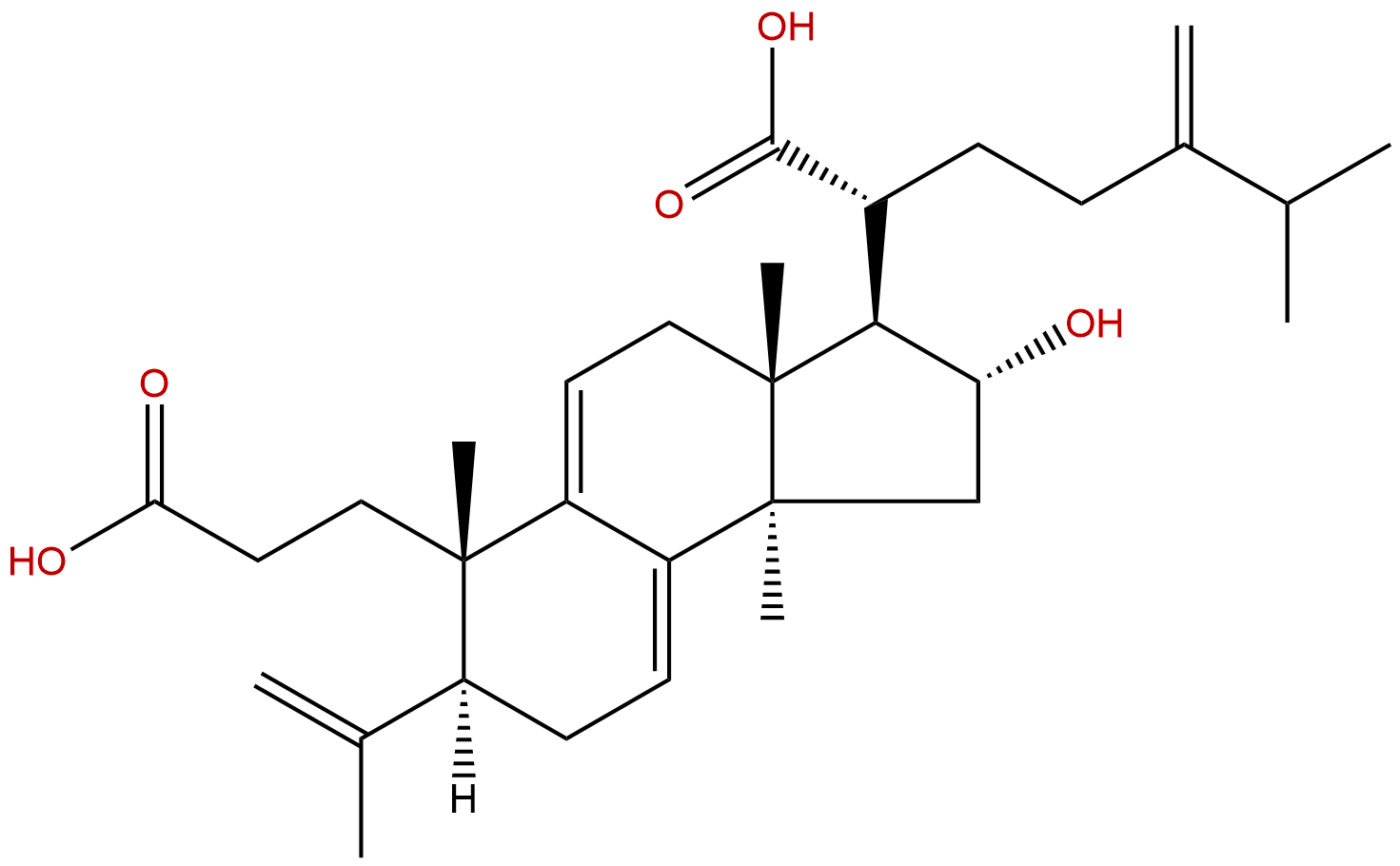
Poricoic acid ACAS No.:137551-38-3
|
||||||||||
 |
|
|
||||||||

| Catalogue No.: | BP1838 |
| Formula: | C31H46O5 |
| Mol Weight: | 498.704 |
Product name: Poricoic acid A
Synonym name: Poricoic acid F
Catalogue No.: BP1838
Cas No.: 137551-38-3
Formula: C31H46O5
Mol Weight: 498.704
Botanical Source:
Physical Description: Powder
Type of Compound: Triterpenoids
Purity: 95%~99%
Analysis Method: HPLC-DAD or/and HPLC-ELSD
Identification Method: Mass, NMR
Packing: Brown vial or HDPE plastic bottle
The product could be supplied from milligrams to grams. Inquire for bulk scale.
We provide solution to improve the water-solubility of compounds, thereby facilitating the variety of activity tests and clinic uses.
For Reference Standard and R&D, Not for Human Use Directly.
Description:
Poricoic acid A(F) shows anti-inflammatory activity. It is a potential whitening active ingredient, it exhibits good inhibitory effects on the activities of monophenolase and diphenolase in mushroom tyrosinase, as well as a certain inhibitory effect on tyrosinase in B16 cells.
References:
Zhongcaoyao, 2017(9):328.
Tyrosinase Inhibitory Activity of Total Triterpenes and Poricoic Acid A Isolated from Poria cocos.
With the improvement of people's living standards, people's requests for beauty are increasing. Skin whitening and lightening have become the pursuit of many women, and whitening and removing freckles have become the focus of scientific research. At present, widely used whitening agents, such as kojic acid, vitamin C, and its derivatives, have shortcomings such as poor stability and retarded effect. Therefore, safer and more effective whitening products from herbs are urgently needed. To explore the possibility of triterpenes as whitening active substance, the effects of total triterpenes of Poria (TTP) and Poricoic acid A(F) (PAA) on mushroom tyrosinase activities and B16 cells were investigated, and their mechanisms on mushroom tyrosinase were also studied.
METHODS AND RESULTS:
Using arbutin and nicotinamide as reference substances, we determinated the inhibitory effects of TTP and PAA on mushroom tyrosinase and tyrosinase in B16 cells and then studied the inhibitory mechanism on mushroom tyrosinase. TTP and PAA exhibited good inhibitory effects on the activities of monophenolase and diphenolase in mushroom tyrosinase, as well as a certain inhibitory effect on tyrosinase in B16 cells.
CONCLUSIONS:
TTP and PAA are potential whitening active ingredients.
Journal of Natural Products, 2011, 74(2):137-144.
Cytotoxic and Apoptosis-Inducing Activities of Triterpene Acids from Poria cocos.
METHODS AND RESULTS:
Six lanostane-type triterpene acids (1a-6a), isolated from Poria cocos , and their methyl ester (1b-6b) and hydroxy derivatives (1c-6c) were prepared. Upon evaluation of the cytotoxic activity of these compounds against leukemia (HL60), lung (A549), melanoma (CRL1579), ovary (NIH:OVCAR-3), breast (SK-BR-3), prostate (DU145), stomach (AZ521), and pancreas (PANC-1) cancer cell lines, 11 compounds (5a, 6a, 2b-5b, 1c, and 3c-6c) exhibited activity with single-digit micromolar IC(50) values against one or more cell lines. Poricotriol A (1c), a hydroxy derivative of Poricoic acid A(F) (1a), exhibited potent cytotoxicities against six cell lines with IC(50) values of 1.2-5.5 μM. poricotriol Ainduced typical apoptotic cell death in HL60 and A549 cells on evaluation of the apoptosis-inducing activity by flow cytometric analysis. Western blot analysis in HL60 cells showed that poricotriol A activated caspases-3, -8, and -9, while increasing the ratio of Bax/Bcl-2.
CONCLUSIONS:
This suggested that poricotriol A induced apoptosis via both mitochondrial and death receptor pathways in HL60. On the other hand, poricotriol A did not activate caspases-3, -8, and -9, but induced translocation of apoptosis-inducing factor (AIF) from mitochondria and increased the ratio of Bax/Bcl-2 in A549. This suggested that poricotriol A induced apoptosis via the mitochondrial pathway mostly by translocation of AIF, independent from the caspase pathway in A549. Furthermore, poricotriol A was shown to possess high selective toxicity in lung cancer cells since it exhibited only weak cytotoxicity against a normal lung cell line (WI-38).